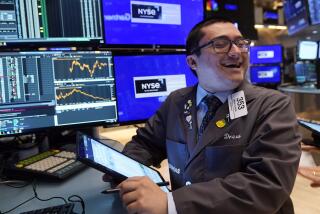There Is a Summer Rally, for Whatever It’s Worth
- Share via
Every year at this time, many stock traders and investors start talking about the “summer rally”--a supposedly seasonal bias for the market to rally in the summer months, as if on cue from the increasing sunlight.
Like so many things on Wall Street, there’s both truth and myth in the summer rally story. The truth is that the market does generally rally in summer. The myth is that this rally typically is the best of the year.
In fact, the summer rally is the weakest of the seasonal rallies, according to the Stock Trader’s Almanac, published in Old Tappan, N.J.
Yale Hirsch, publisher of the Almanac, says the average summer rally has produced a gain of 9.5% in the Dow Jones industrial average over the past 25 years. In contrast, the average winter rally has seen a 13.6% Dow gain, and the spring and fall rallies have returned 10.2% and 10.5% on average, respectively.
Hirsch measures the seasonal rallies from the Dow’s low point in the two months leading into the season to the high point in the season. For example, the summer rally is measured from the lowest Dow close in May or June to the third-quarter high.
The best summer rally was in 1987, a 22.9% rise in the Dow. The worst: 1981, a 0.4% rise. Point is, there’s always some kind of rally in every season--because the market almost never goes straight down for five straight months.
David Dreman, a veteran money manager in New York, notes that the summer rally story “goes back to the 1920s. There’s never been any substantiation for it.” The theory partially has been based on the belief that people feel better in the summer, simply because it’s vacation season. That improved mood is supposed to translate into a willingness to buy stocks. Likewise, some traders have suggested that the market always improves whenever Congress goes home--where lawmakers can’t do any damage to the economy.
Another theory: When institutional investors go off to the beach in July and August, market volume dries up, leaving individual investors with more influence in the market, and their influence is supposed to be more to buy than sell, on average.
In any case, Hirsch’s statistics ought to put the summer rally in perspective, once and for all. So what about this year? Well, the Dow already is up 6% from its May low of about 2,670. If you accept the 9.5% average summer rally, that doesn’t leave a lot of room to zoom--unless, of course, some traders decide to get a jump on the fall rally. . . .
Future Fund Shock? Mutual funds proved to be a magnet for individual investors’ dollars in the 1980s. But now what?
A forecast of the industry’s future, commissioned by the funds’ chief trade group, the Investment Company Institute, suggests that the funds will face growing competition in the 1990s--which should be good for investors, even if it leaves them with an even more bewildering array of financial products from which to choose.
More important, perhaps, study author Heidi Fiske of New York-based Fiske Associates sees the funds reaching investors in a host of new ways--all leading to “the return to power of the individual investor” in the 1990s.
Some highlights from an early summary of the report:
* Fund investors are likely to demand--and get--more financial information and even advice over the phone or via computers from fund companies. This will occur “as the fund buyer’s education and financial sophistication rise, and technology makes it possible for the buyer to do many ‘what-ifs’ over a phone, with a computer, faster than would be possible with a human being.”
Fiske notes that fund phone-service personnel, using computers that supply virtual real-time information on customers’ accounts, already are answering questions that would have been answered only by a broker until recently.
* Commercial banks are likely to be allowed by Congress to offer their own mutual funds directly to investors before mid-decade, Fiske predicts. Those competing funds, along with brokerage products that pool individuals’ money to invest in new areas, will probably slow fund asset growth to 12% a year in the ‘90s, versus 30%-plus annual growth from 1978 to 1989.
* The most promising markets for mutual funds to tap are the “insti-vidual” markets. These are markets where a decision to bring a fund group to an audience is made by an institution, such as an employer, but the decision on whether and what to buy is made by the individual. An example of this is company 401(k) retirement plans, which give the individual a choice of investments for retirement savings. Growing use of that type of product is why Fiske believes individual investors will gain increasing power over financial markets in the 1990s.
THE FUNDS: $1 TRILLION-PLUS
How mutual fund assets have soared, including stock, bond and money-market funds.
More to Read
Inside the business of entertainment
The Wide Shot brings you news, analysis and insights on everything from streaming wars to production — and what it all means for the future.
You may occasionally receive promotional content from the Los Angeles Times.










